How many different jazz guitar chords do you think you need to know to play jazz?
I know what you’re thinking…a LOT.
But:
There’s a clever trick I want to share with you today.
By knowing how to play just a few basic chord shapes on the guitar, you can quickly learn to play a massive amount of different jazz chords – without even needing to memorize them all.
Get your FREE Handy PDF Download: Click this link to get your free printable PDF which has the tabs, jazz chords chart, and diagrams for this lesson.
Make sure you stay till the end of this video lesson, as I’ll show you how to learn to switch between these chord shapes efficiently with some tasty jazz chord exercises.
Let’s dig in!
Video Sections:
00:00 Introduction
00:45 The Three Harmonic Families
02:08 ii V I Progressions
02:28 Jazz Chord Shapes for the ii V I Progression
02:52 The V Chord
03:34 Shell Voicings
04:24 Colouring Shell Voicings
05:24 Barre Technique with the Second or Third Finger
07:55 The ii Chord
08:44 Muting Strings with the Left Hand
09:50 Omitting Bass Notes
10:39 The I Chord
12:17 6 Voicings
13:32 Backing Track
14:47 Extra Chord Qualities (Subtypes)
16:02 Minor ii V i
16:37 Altering Chords Quality
17:15 Adding Altered Tension
19:35 Colouring the i Chord
21:07 Minor ii V i Backing Track
First things first:
To understand how this clever system works, we need to investigate a concept known as the Three Harmonic Families.
Let’s take the lead from one of the greatest jazz guitarists that ever graced the earth: the fabulous Joe Pass.
Jazz harmony can seem very complicated if you read it from theory books.
But:
Joe Pass was very clever in keeping things as simple as possible, using the “Three Bucket Method:”
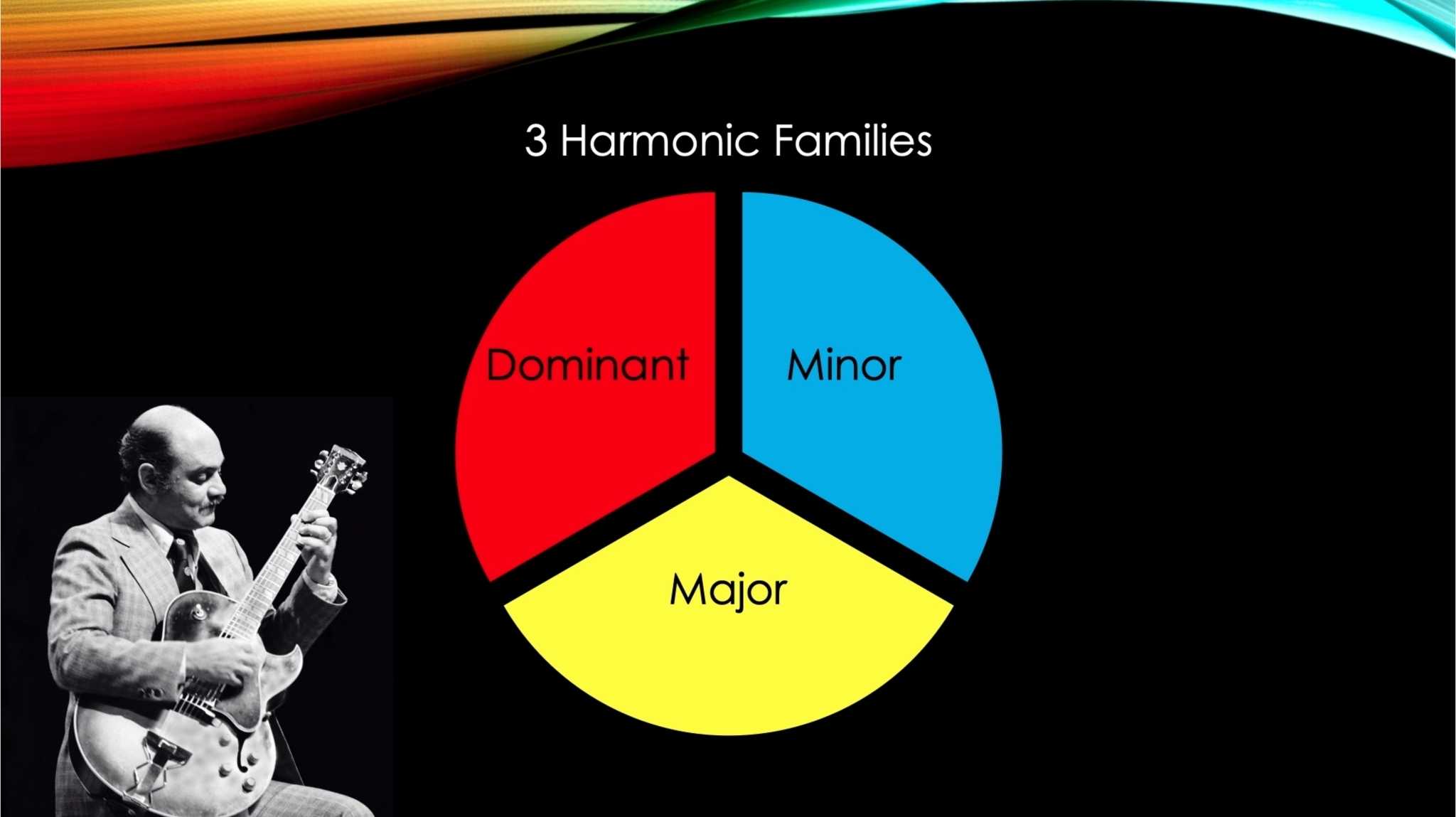
Whether or not you’re playing Giant Steps or Happy Birthday guitar chords, the following framework is relevant.
According to Joe Pass, every chord in existence, can belong to one of the following ‘buckets’:
- Major chord
- Minor chord
- Dominant Seventh chord
Interestingly:
These are the only three types of chords in western music when you boil things down.
Whether it’s a complicated-looking jazz chord symbol like G7b13#9, C9sus, Ebdim7, or any other crazy-looking chord, its fundamental essence can only be a major, minor, or dominant.
So (and here’s the best part):
If you know the basic shapes of these three chord types – you must be able to play any jazz song you like!
Let’s explore how you can quickly get these three types of chords under your fingers.
Learn Jazz Guitar Chords With The Amazing ii – V – I Progression
The quickest way to master the three ‘buckets’ of chords is by learning how to play ii – V – I progressions, as these chord progressions have the three types of chords included:
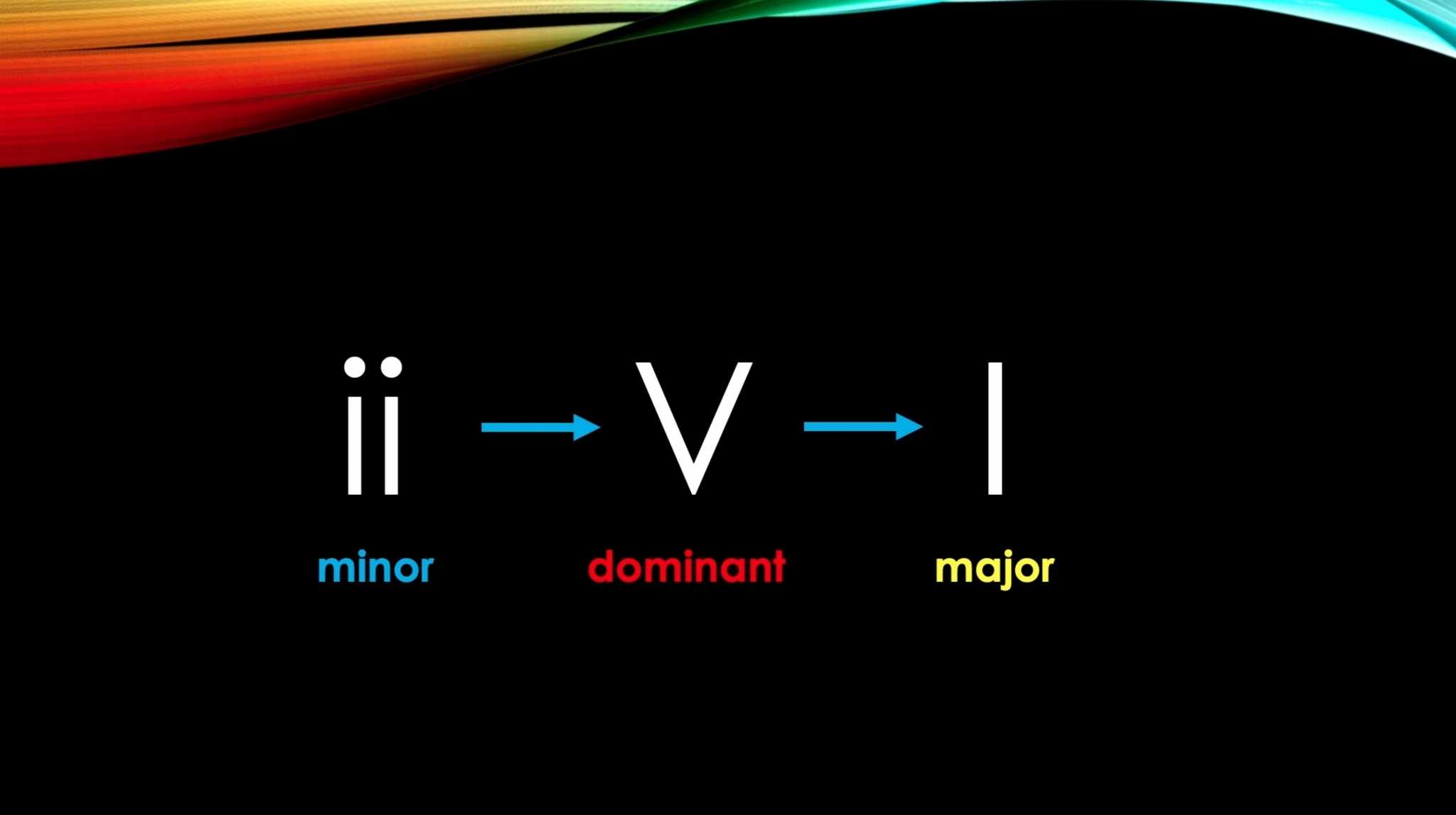
– the ii chord is minor,
– the V chord is dominant, and
– the I chord is major.
Now, let’s look on the fretboard to learn how to play an ii – V – I progression with some groovy jazz chord shapes.
The ii – V – I Major Jazz Guitar Chord Progression
Here’s the first jazz guitar chord you’re going to learn that comprises a ii – V – I progression.

Let’s look at each chord one by one.
Hint: Click here to get a printable PDF copy of all the chord diagrams covered in this lesson.
D7 Chord (The V chord)
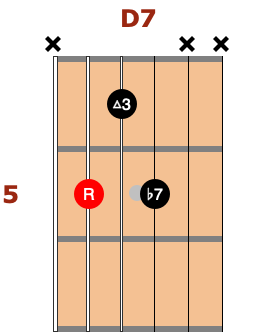
Let’s start with one of the easiest chord shapes to play and remember. Notice how this D7 chord forms a ‘triangle’ shape with your fingers.
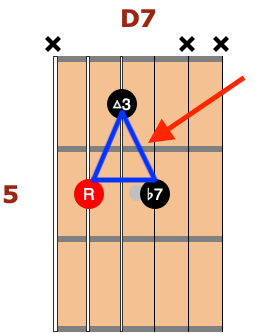
This shape has the bare bones of the chord outlined to define the chord quality – the root, the 3rd, and the 7th. Chord shapes that only have these essential tones are called shell voicings.
Important note: For shell voicings chord shapes like this one, pay close attention to the chord diagram. Don’t strum all the guitar strings – only strum or pluck the ones you’re holding your fingers down on. If you strum all the strings, you’ll introduce many clashing notes and sound strange. (You should avoid playing open strings on most moveable jazz chords on the guitar.)
Shell voicings are wonderfully helpful in many jazz guitar situations as they are easy to play but sound great when comping or playing chord melody.
Adding extra notes to a shell voicing
Shell voicings will sound great for comping in the band as they fill out the rhythm section without overpowering other players – or clashing with other harmony instruments like the piano.
But you can add extra chord tones to shell voicings to make them more colorful.
By using your free fingers, you can get new chord voicings from just one basic shape, such as this D9 chord:
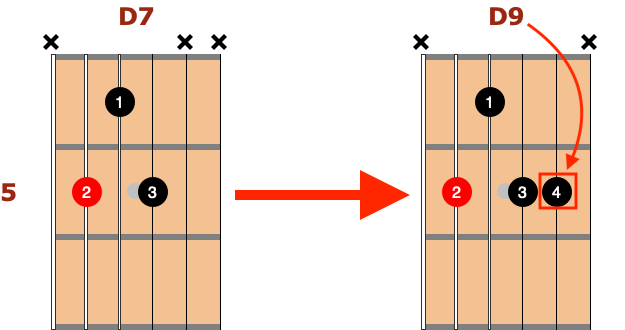
Using 2nd or 3rd finger barres:
In the previous example, I used my 4th finger to add the extra note to make a D9 chord.
But:
I can use a 3rd finger barre instead, like this:
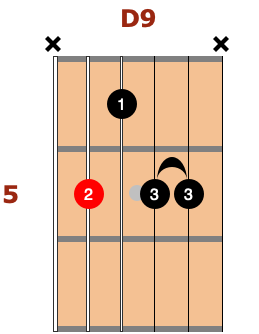
The reason:
It gives you another free finger to add additional notes on jazz chords for even more variety. Using a 2nd or 3rd finger barre in this way is a trick used often by jazz guitarists.
Now I’ve got my trusty pinky finger available at my disposal, let’s see what extra tasty notes I could add:
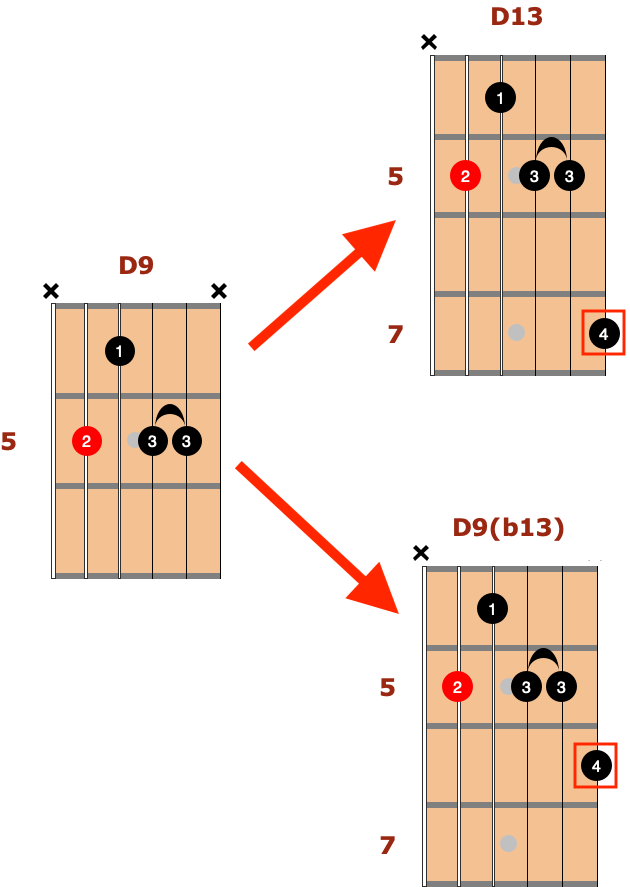
Pretty cool, huh?
Technique tips for 2nd and 3rd finger jazz barre chords
Although they can be initially awkward, it’s worth learning this barre technique for jazz.
If you play other guitar styles (like rock or classical), you’re probably already familiar with a 1st finger bar, but you may find 2nd or 3rd finger barres a bit unusual.
To play these types of barres effectively, ensure your fretting hand thumb is high above the fretboard, and then roll your hand to clamp the barre down over the strings:
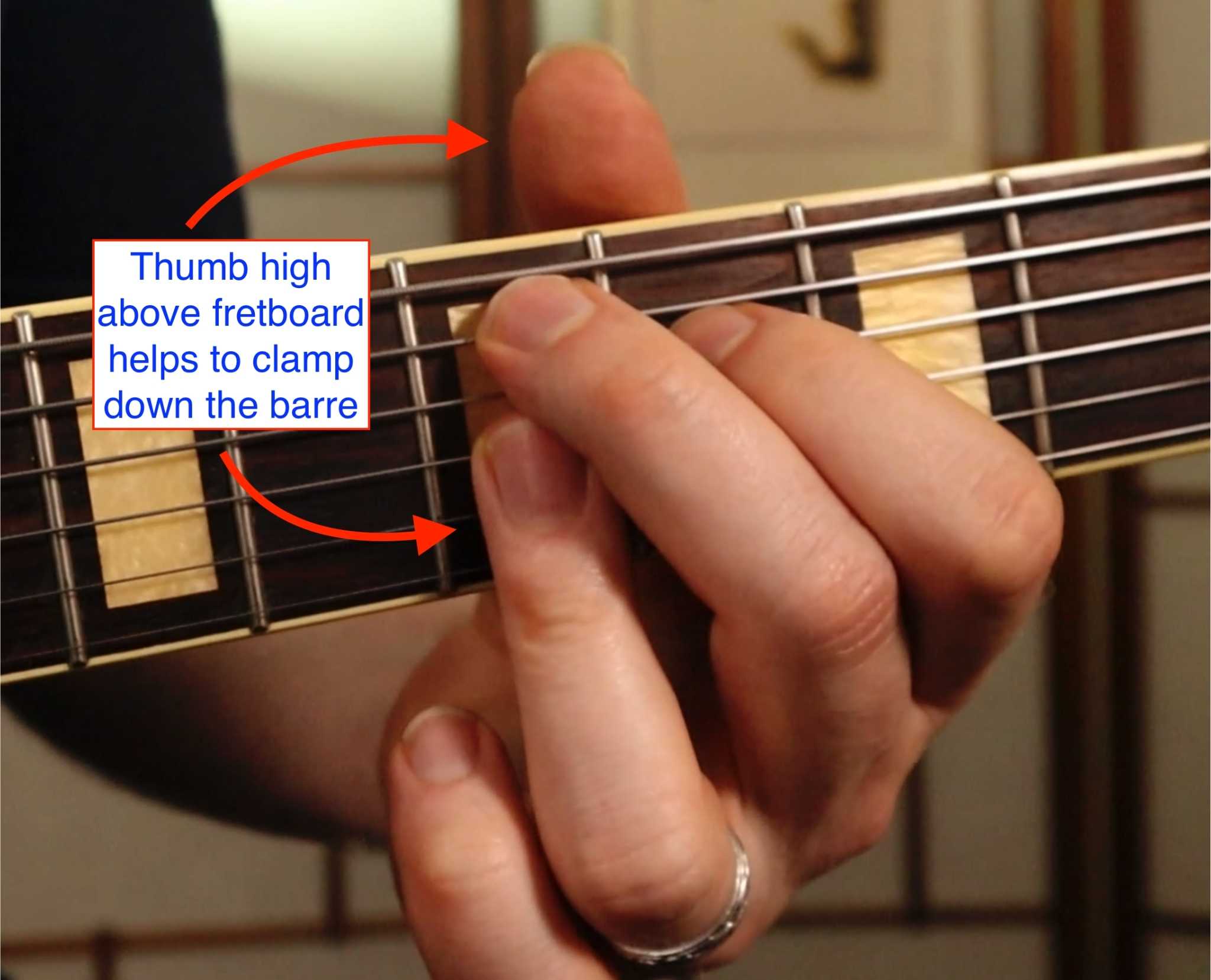
You don’t want your thumb in the middle of the guitar neck for these chords – this will strain your hand and make these chords very difficult to play.
Tip: Check out the video at the top of this page (fast forward to around 6 minutes in) for detailed instructions on playing these chords with good technique to avoid any potential injury.
Am7 Jazz Guitar Chord (The ii chord)
Let’s now have a look at the first chord in the progression – the Am7 chord:
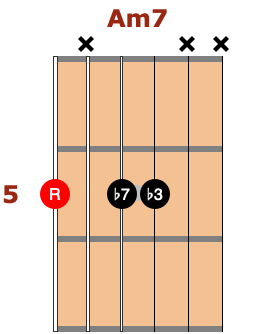
Depending on what you’re playing style is (and what would make the most sense to get to the next shape in a song), you could play this chord in a variety of ways:
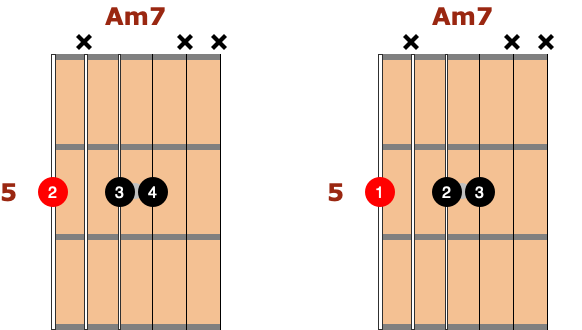
However, just like the D9 chord I demonstrated earlier, I (usually) prefer to use a 3rd finger barre to play this jazz guitar chord shape:
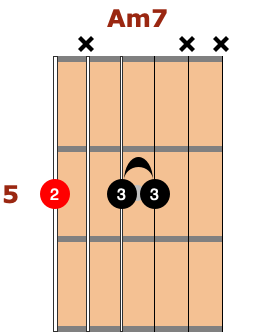
Reasons for the barre:
- I can use the barre to mute unwanted strings, producing a cleaner sound. In this example, the 2nd finger mutes the 5th string, and the 3rd finger barre mutes the 2nd and 1st strings.
- This ability to mute the strings makes it much easier to strum the chord, which results in a cool percussive sound that is useful for jazz.
- Fingering the Am7 in this way is similar to the D9 chord, so it’s straightforward to switch between Am7 and D9, which is particularly useful for this ii – V – I progression.
Just like with the D7 shell voicing, there are many classy voicings I can get from this shape by adding additional notes to the chord (check out the following jazz chord chart):
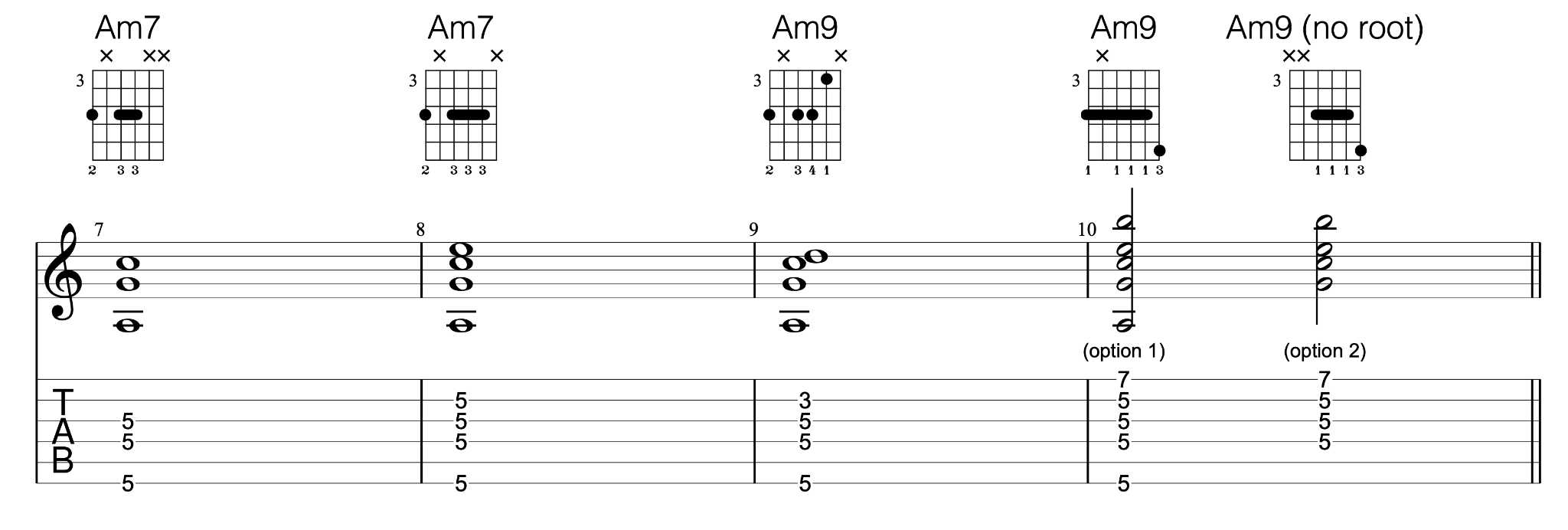
Hint: See this PDF Download for all the variations of the chords I use in the video.
You can think of shell voicings as a ‘coathanger’ for your memory. The bare shell voicing shape is easy to remember, but add additional notes to add many new voicings to your comping and chord melody guitar arsenal.
Ditching the bass note for even MORE chord voicings
Another way to free up your hand for more interesting voicings is to remove the bass root note from the shape:
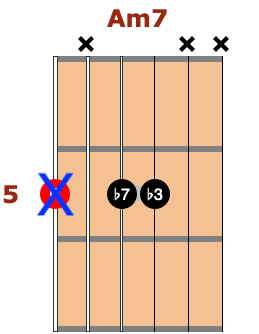
This handy approach was used a great deal by the jazz guitar master Lenny Breau.
Why omit the bass note?
The reason:
The bass player in your band will be playing that root note anyway.
By cutting out the bass note from a shell voicing, your fingers will be freed up to easily play extra color notes on the upper strings, like so:
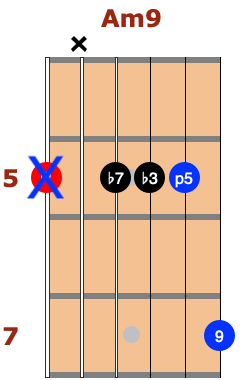
Super helpful – by omitting the bass note, you open your fingers up to exotic new voicings.
Gmaj7 Jazz Chord (The I chord)
Now let’s look at the Gmaj7, chord I in this ii – V – I progression. This is one of the most common jazz chord shapes:
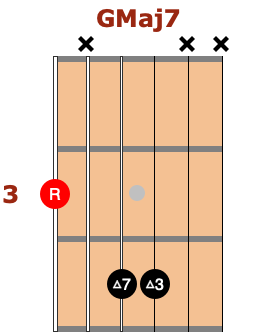
Heads up:
If you’re strumming this chord (as opposed to plucking), avoid playing the open fifth string, as it will clash. Instead, only aim to play the strings held down by your fingers – no open strings!
By either utilizing a barre or adding extra notes to this basic shape, I can create a variety of wonderfully colorful voicings:

Adding extra color notes to basic chords like this is one of the secrets to expanding your chord vocabulary.
Side note: 6 chords
In jazz, it’s common practice to often use a 6 chord (e.g., G6) instead of a Maj7 chord (e.g., Gmaj7):
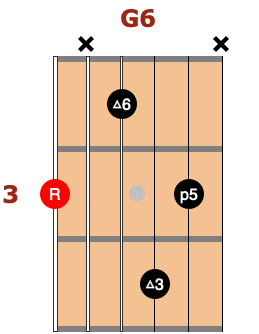
The reason:
In more traditional jazz standards, the Maj7 chord can sound a bit too harsh at times.
6 chords (like the voicing pictured above) can give a gentler sound that works particularly well for the endings of jazz songs.
Jazz Guitar Chords Exercise – Major ii – V – I Comping
This is where the rubber hits the road – time to practice jazz guitar chords the smart way!
Now that we’ve learned some cool jazz guitar chord voicings, let’s put them to work over a backing track.
Let’s use a basic Charleston comping rhythm for the following exercises to get a cool swing feel into your playing.
Hint: Want to get a download of the backing tracks and PDF sheet music I’m using for this lesson so you can practice them at home? Click here to access the freebies now >>
Exercise 1 (see video at 13:32)
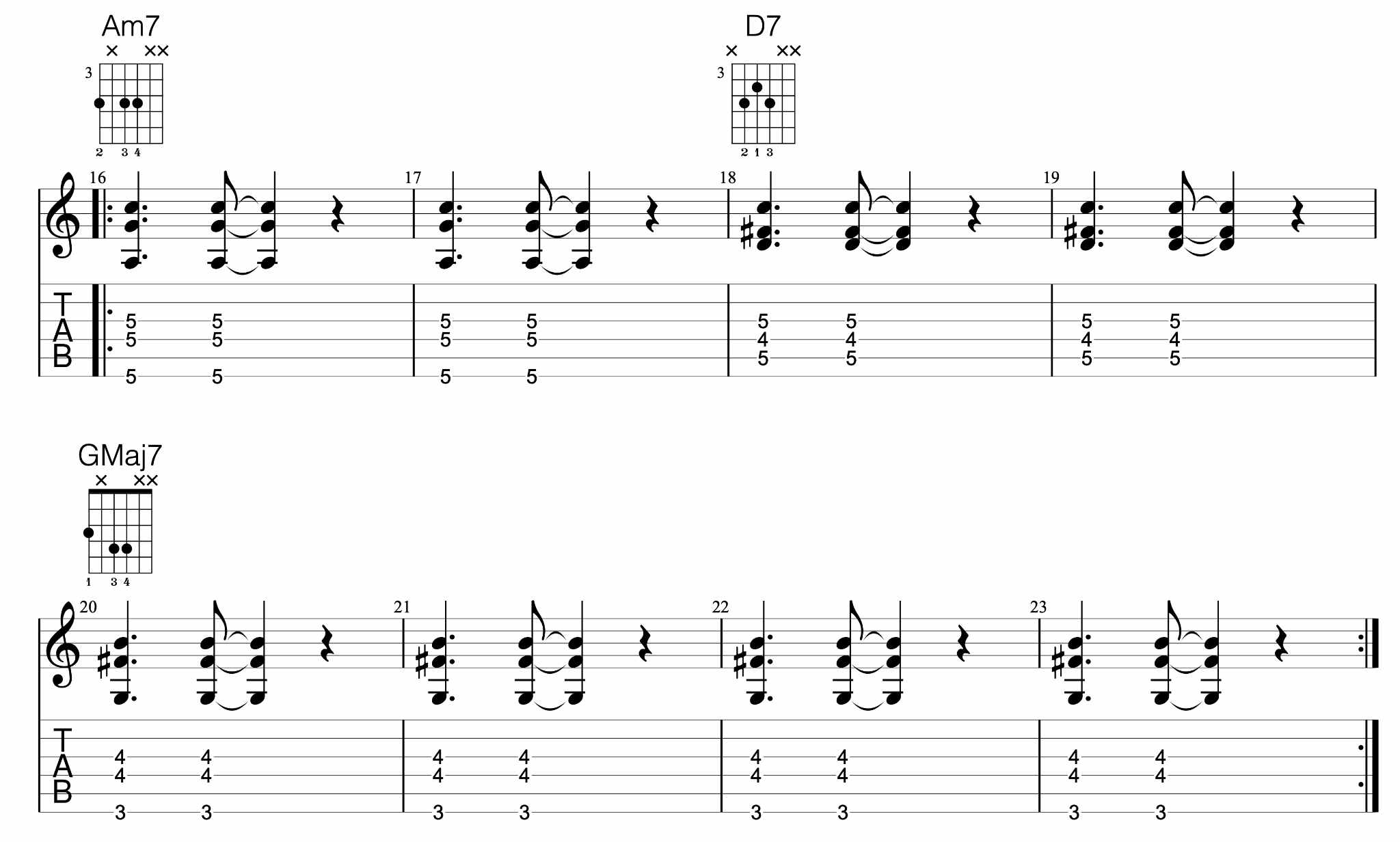
Listen & Play:
Exercise 2 (see video at 14:00)


Listen & Play:
Reminder: Get a complete PDF of these exercises and bonus downloadable backing tracks by clicking this link.
Fantastic! We’ve comprehensively covered the chord shapes needed to play an ii – V – I major progression.
You are now 80% of the way towards being able to play any chord in a jazz song.
But:
Read on – there are a few chord types we still need to cover…
The Minor ii – V – i Jazz Chord Progression
There’s more to the Three Harmonic Families I covered earlier. Check out the following diagram:
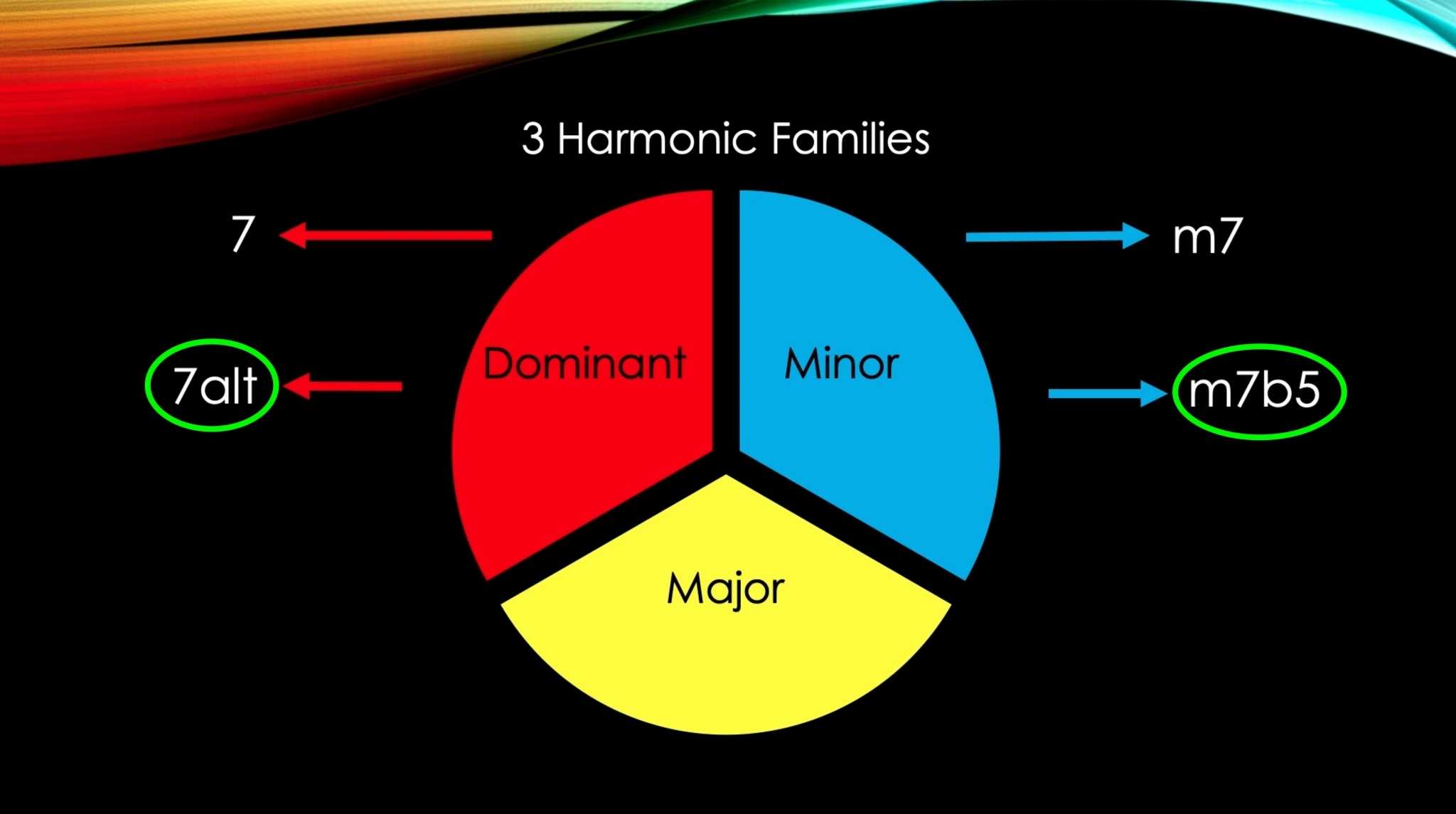
As you can see:
There are a couple of ‘subtypes’ of minor and dominant chords we haven’t covered yet (circled green):
– minor seven flat five (m7b5) – otherwise known as ‘half diminished’
– altered dominant (7alt)
m7b5 chords have a darker sound to them compared to regular m7 chords.
‘7alt’ is a general term for dominant chords with altered tensions – e.g., G7b9, G7b13, etc. These kinds of ‘outside’ notes applied to the dominant give a much tenser sound than ‘straight’ dominant chords.
These chord types are essential knowledge to play jazz chord songs effectively.
The good news:
Another common jazz chord progression includes these new chord types to make learning and practicing them a breeze: the MINOR ii – V – i progression.
Let’s look at each chord from a G minor ii – V – I chord progression below.
Am7b5 Chord (The ii chord)
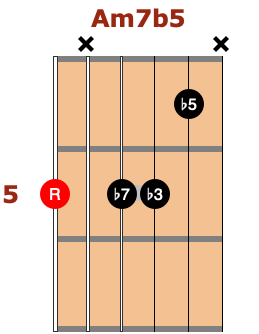
Yes, I know…
I said there were only going to be three basic shapes. And now I’m adding another three ????
But:
Notice how similar Am7 and Am7b5 are:
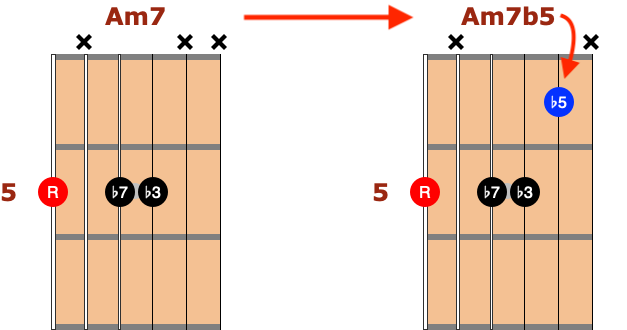
(Note: In case you were wondering – m7b5 and half-diminished chords are the same thing.)
The good news:
Am7b5 has merely one extra note added – the b5 tone. It acts as an additional color to get a darker sound.
If you ever get stuck trying to remember the Am7b5 chord shape…
Recall where the notes are in the Am7 shell voicing shape, change the fingering a little, and add 1 note. Easy!
D7b9 Chord (The V chord)
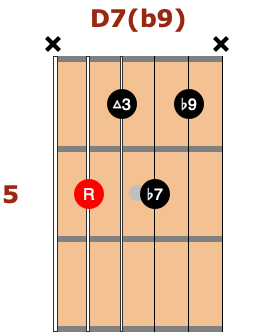
Now, let’s have a look at some altered dominant voicings.
The term ‘altered’ refers to adding notes that don’t usually exist in the home scale of the key.
When you see a 7alt chord symbol, you could add several different tensions to a dominant chord to make it ‘altered’: b5, b9, #9, b13 – or a combination of these.
Once again, taking our basic ‘triangle’ shape of the D7 shell voicing, I can add various tensions to this chord using barres or my free finger to create altered voicings:

Joe Pass often mentioned that you need to create this kind of tension on dominant chords for jazz – it makes for a lot more ‘spice’ and is very much part of the soul of the jazz sound.
Gm7 Chord (The i chord)
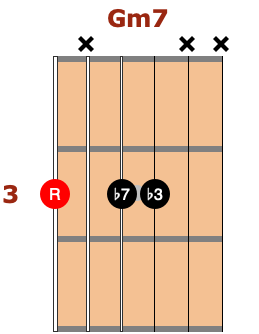
This one is the easiest of the bunch.
We’re now using an m7 chord for the i chord – which means you simply slide down the Am7 voicing down two frets:
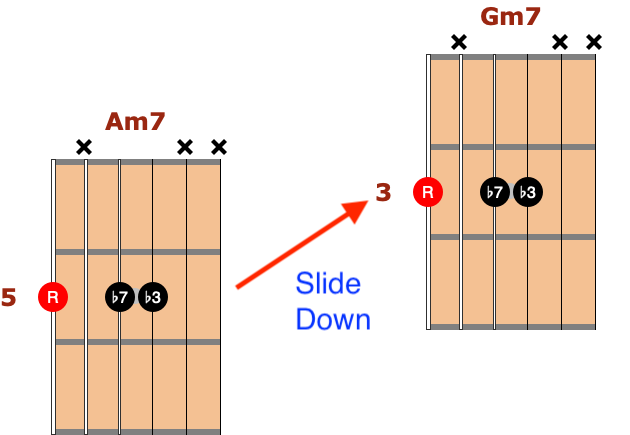
As we did with the Am6 can add a 9th on the top of the Gm7 shape to create a classy sound:
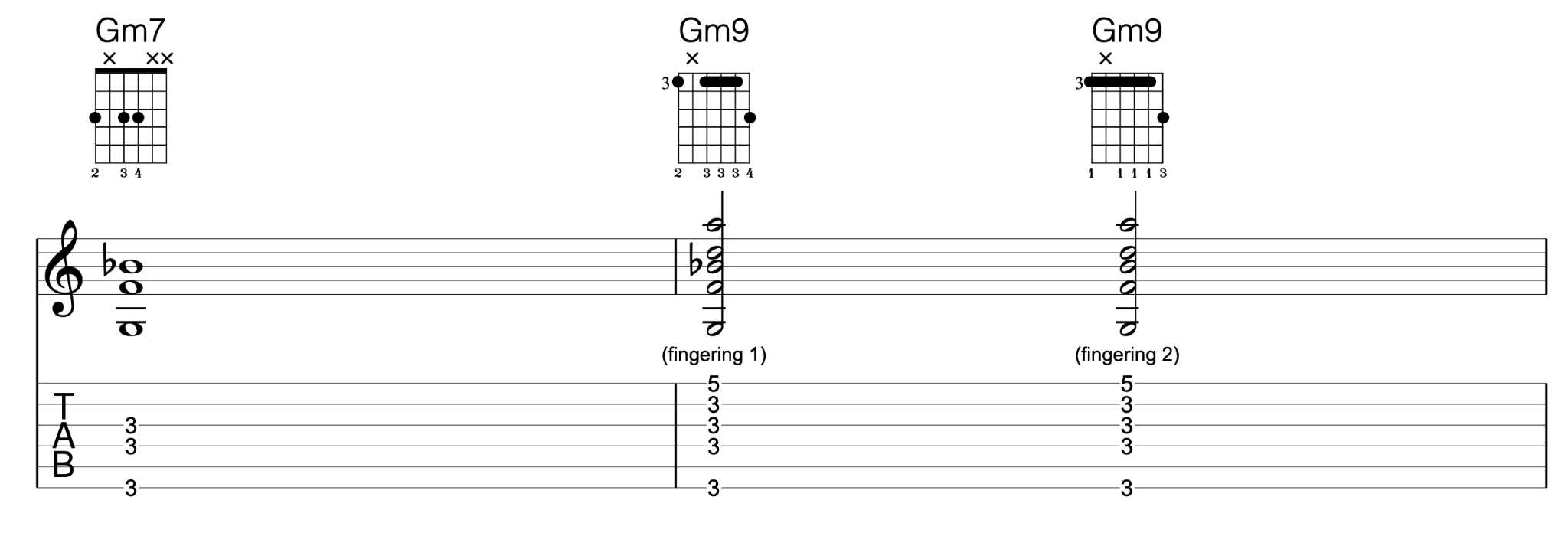
You don’t want to add altered tensions to this chord as it won’t sound right – this is the home chord for the key.
However, for more color – you could use a Gm6 chord as a substitute for a hip sound:
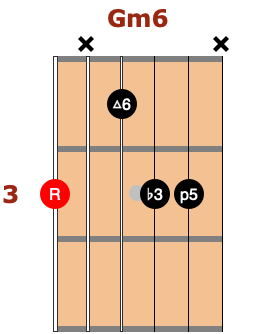
Jazz Chord Exercise – Minor ii – V – I Practice
You are nearly there, my jazz guitar apprentice!
To round out this lesson, practice these shapes over a minor ii – V – i progression like this:
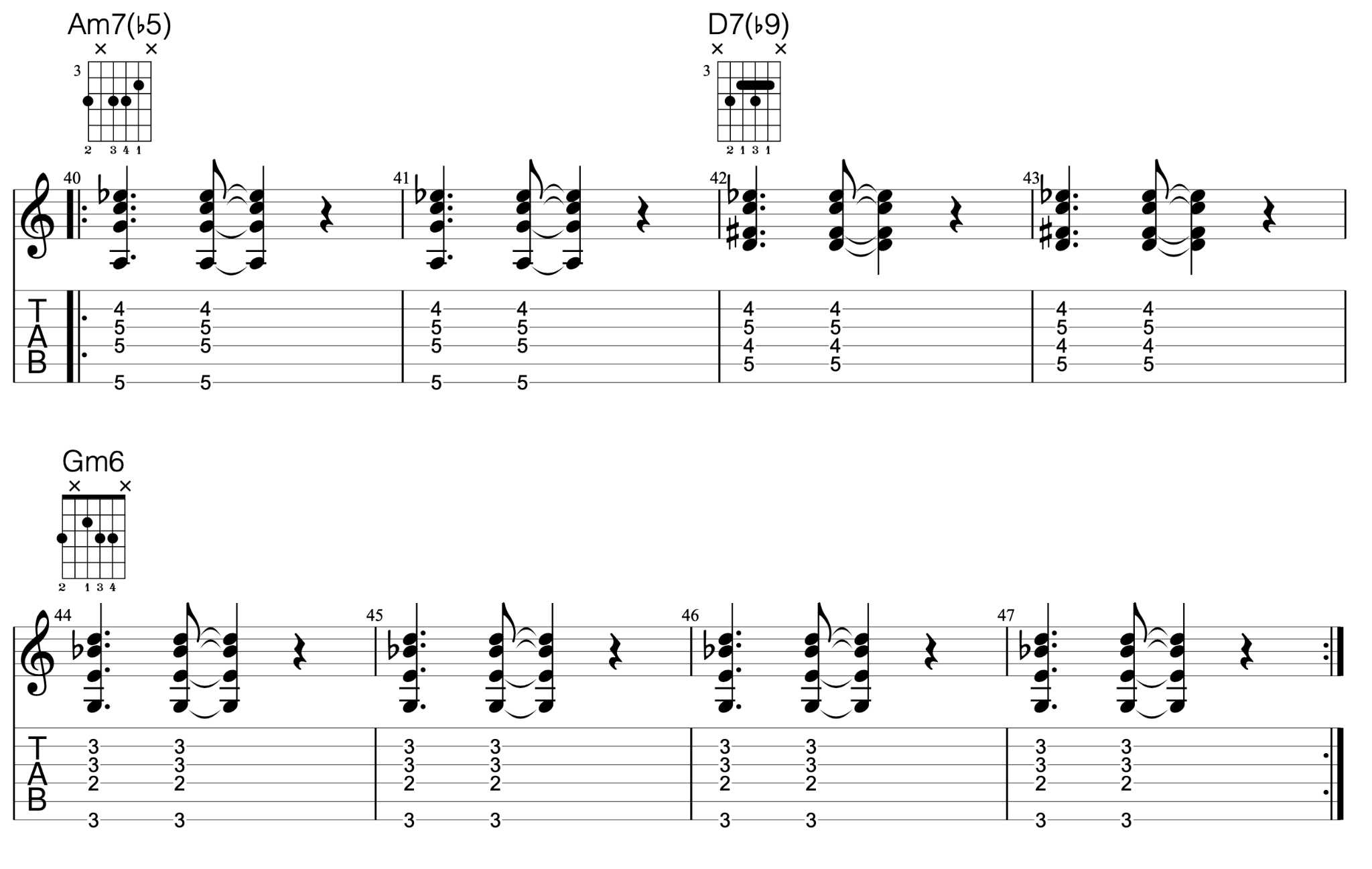
Listen & Play:
Reminder – Bonus PDF Download: Get a complete PDF of these exercises and bonus downloadable backing tracks by clicking this link.
The Easy Jazz Chords Solution:

Fantastic work! You’ve now armed yourself with the essential jazz guitar chord shapes you need to know to hold your head above water at a gig.
As you can see from today’s article, shell voicings are the key to unlocking hundreds of chord variants for jazz guitar, which you can then use for guitar comping or chord melody. The possibilities for your jazz chords are endless!
I hope you enjoyed today’s lesson on easy jazz guitar chords. Let me know what you think by leaving a comment below. I look forward to seeing you in my future jazz guitar lessons!
Greg O’Rourke
BMus (Hons), ANU
Founder, FretDojo
World Leader in Online Guitar Education.
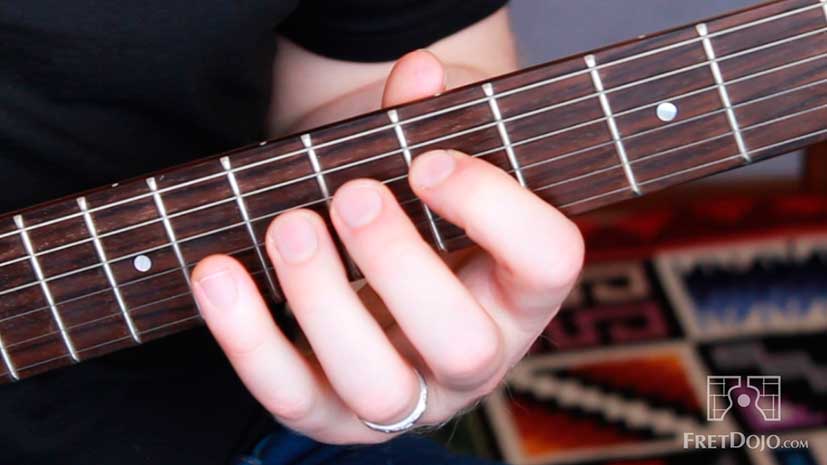
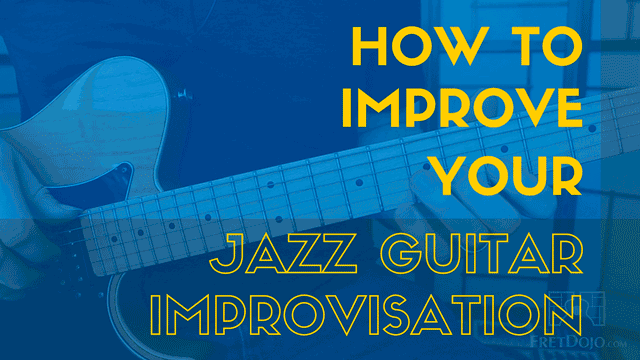
Thanks Greg, always been partial to a bit of jazz, love the basic shell approach and the lego building brick method of assembling chords in a modular fashion. Having worked on production lines, it’s easy to picture and familiarise yourself with the brick by brick development of each chord.
Great summary Greg !
I have been playing jazz guitar for about 10 years and you have captured the essence of shell chords, extended chords, and partial chords used by Joe Pass, Ed Bickert or Lenny Breau. You also nailed the ‘key’ concept of 2-5-1 cadences in major and minor keys used everywhere in jazz standards.
I learned these shapes and voicings “the hard way”. You provide a more concise and condensed fast track “easy way” for less experienced players .
VERY Well done !
As a cripled octogenerian, I cannot play the guitar anymore but simply love watching this fascinating type of video. Great presentation, Greg!
Very cool. There’s a chord in ‘Deacon Blues’ I’ve played for years labelled a ’13’ and I never analyzed it. I just memorized and played it, which means sometimes I’d forget the fingering. Now I realize it’s the basic major 7 chord (from the video) with the finger on the 3rd moved to the 4th. Thinking of it like ‘Legos’ I’ll never forget how to finger it.